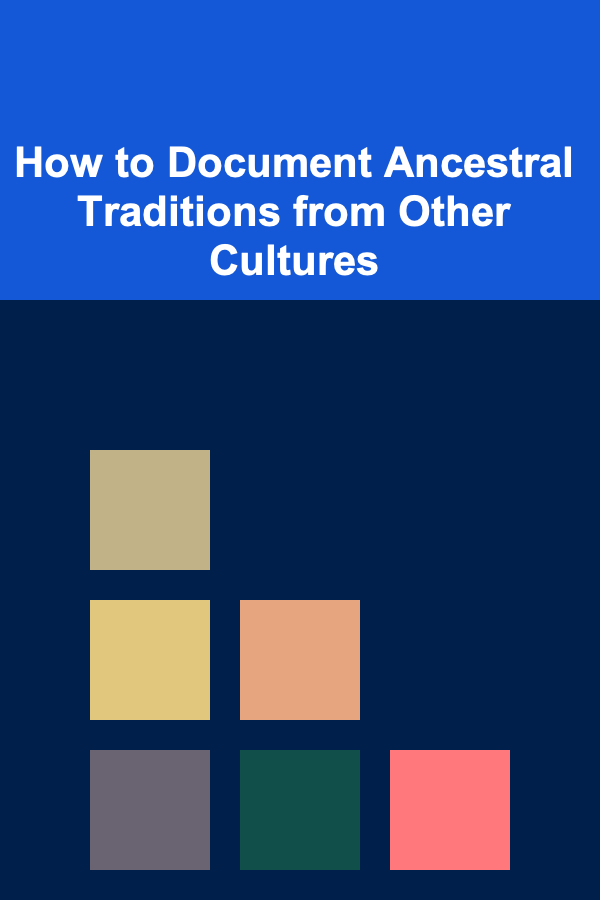
How to Document Ancestral Traditions from Other Cultures
ebook include PDF & Audio bundle (Micro Guide)
$12.99$9.99
Limited Time Offer! Order within the next:

Documenting ancestral traditions from other cultures is a crucial task for preserving the rich diversity of humanity's history, knowledge, and practices. Traditions, which include rituals, customs, folklore, language, art, and religious practices, are the backbone of cultural identity and offer insights into how people have lived, thought, and interacted with their environments throughout history. However, this process of documentation is not just about recording facts---it involves understanding, respecting, and engaging deeply with the culture in question. This article outlines a thorough, respectful, and effective approach to documenting ancestral traditions from other cultures.
Understanding the Importance of Documenting Ancestral Traditions
Before beginning the task of documenting traditions from another culture, it is essential to understand why this is such a significant endeavor. Cultural traditions are the living expressions of human experience that link the present to the past. They are not static; they evolve over time, reflecting changes in societal values, technology, and interactions with other cultures. By documenting these traditions, we not only preserve them for future generations but also safeguard the knowledge and wisdom embedded within them. This helps prevent the loss of valuable cultural heritage due to globalization, war, colonization, and other forces that may lead to cultural homogenization.
Moreover, documenting these traditions is a powerful tool for fostering understanding and respect across different cultures. It helps break down stereotypes, promotes intercultural dialogue, and provides an avenue for mutual learning. It also ensures that cultures whose traditions may not have been adequately recorded, or which have been historically marginalized, can assert their presence and continue their legacy.
Respecting Cultural Sensitivity
One of the first principles in documenting ancestral traditions from other cultures is the need for respect. Cultures are not just a collection of facts to be written down but are living, breathing entities that represent the values, struggles, and worldview of a community. As such, it is crucial to approach the documentation process with a sense of humility, openness, and a commitment to respecting the rights and perspectives of the people whose traditions you are documenting.
This starts by recognizing that some traditions may be sacred or private. Certain ceremonies, rituals, or practices may not be intended for public sharing, especially if they are deeply tied to spirituality, religion, or indigenous ways of knowing. Therefore, it is necessary to seek permission from the relevant cultural leaders, elders, or community representatives before documenting any practices. This permission may involve negotiating boundaries around what can and cannot be shared publicly.
Additionally, one must acknowledge that even within a single culture, there can be varying interpretations and practices. Traditions may differ from region to region, community to community, or family to family. Understanding the local context is paramount in ensuring that the documentation process does not oversimplify or misrepresent the complexity of the traditions.
Building Trust with the Community
The process of documenting traditions should never be rushed, nor should it be undertaken in isolation. Building trust with the community whose traditions you are documenting is essential for success. Trust ensures that you will be able to access accurate information and receive candid insights into the culture, as well as access to rituals, festivals, and individuals who may possess intimate knowledge of the tradition.
Start by engaging with community leaders, elders, and cultural custodians who are knowledgeable about the traditions you wish to document. Establish a relationship based on mutual respect, learning, and dialogue. Let the community members guide you in understanding the significance and context of their traditions. Being patient, listening attentively, and being willing to learn will help in cultivating trust. In some cultures, it may take time to demonstrate your genuine interest and respect for the traditions before you are given access to them.
In addition, it is critical to be aware of any power dynamics that may exist. Some cultures have experienced oppression or exploitation in the past, and as a result, they may be wary of outsiders documenting their traditions. Acknowledge this history and ensure that your efforts to document these traditions are collaborative and mutually beneficial.
Utilizing Multiple Documentation Methods
There are various methods of documenting ancestral traditions, each of which plays a unique role in capturing different aspects of culture. The most effective documentation approach combines several methods to ensure a holistic and nuanced portrayal of traditions. The following methods should be considered:
4.1. Oral Histories and Interviews
Oral traditions are a central component of many cultures, and oral histories often contain rich insights into a community's practices, values, and worldview. Through interviews with elders, storytellers, and other cultural bearers, you can gain firsthand knowledge of a tradition's meaning and history. Conducting oral history interviews requires careful planning to ensure that the conversations are respectful, sensitive, and conducted in a way that allows the interviewee to share their knowledge fully.
During interviews, it's important to ask open-ended questions that allow for deep, thoughtful responses. Ensure that the interviewee feels comfortable sharing their knowledge, and avoid interrupting or imposing your own views on their answers. Consider recording the interviews (with permission), as this will provide a lasting record of their knowledge.
4.2. Photographs and Videos
Visual documentation can be incredibly powerful in capturing the essence of cultural traditions. Photographs and videos provide a way to visually preserve rituals, festivals, dances, and other aspects of a culture that may be difficult to describe in words alone. However, it is essential to approach visual documentation with sensitivity. In some cultures, photography and videography may be considered intrusive or inappropriate, especially during certain ceremonies or rituals.
Before taking photographs or videos, seek permission and clarify how the images and recordings will be used. Additionally, be mindful of framing and perspective---your goal should be to capture the tradition in a way that honors the community's vision of itself.
4.3. Written Documentation
In addition to oral histories, it is important to document the traditions in writing. This can include transcriptions of interviews, written descriptions of rituals and ceremonies, and written accounts of traditional knowledge. Written documentation is useful for preserving specific details, providing a reference for future generations, and ensuring that the knowledge is not lost over time.
Written documentation should be approached with care to avoid misinterpretation. It is important to take the time to understand the meaning behind the practices and use precise language when documenting. This may require consulting experts or cultural advisors to ensure the accuracy of the information.
4.4. Field Notes and Participant Observation
Participant observation is a valuable tool for documenting traditions, especially those that involve active participation, such as dances, festivals, or cooking practices. By immersing yourself in the community and participating in their cultural events, you gain a deeper understanding of the traditions and practices. Field notes, which are written records of your observations, can provide additional context and insights into the traditions that may not be immediately obvious during the event itself.
It is important to approach participant observation with humility and an open mind. Recognize that you are entering a space that is not your own, and be respectful of the customs and etiquette of the community. Avoid disrupting the flow of the event, and always ask for permission before documenting any aspect of the activity.
Ethical Considerations
Documenting traditions from other cultures is an inherently sensitive process, and it is crucial to be mindful of ethical considerations throughout the documentation process. These include:
5.1. Cultural Appropriation vs. Appreciation
It is important to be conscious of the line between cultural appropriation and cultural appreciation. Cultural appropriation occurs when elements of a culture are taken out of context, commodified, and used without respect for the culture or community from which they originate. On the other hand, cultural appreciation involves genuinely understanding, respecting, and engaging with a culture in a way that honors its values and history.
When documenting traditions, ensure that the community's voice remains central in the process. This means avoiding the tendency to exploit or commercialize their traditions. Instead, the documentation should empower the community and highlight their agency in preserving their own heritage.
5.2. Consent and Confidentiality
Always seek informed consent before documenting any aspects of a culture. This means explaining to community members what the documentation entails, how their stories will be used, and ensuring that they are comfortable with the process. In some cases, it may be necessary to create agreements or contracts that outline the terms of the documentation.
It is also important to respect the privacy and confidentiality of the people you work with. Some aspects of their traditions may be considered private or sacred and should not be shared without explicit consent. Ensure that sensitive information is treated with the utmost respect.
Conclusion
Documenting ancestral traditions from other cultures is an invaluable endeavor that helps preserve the richness and diversity of human heritage. By approaching the task with respect, empathy, and a commitment to ethical practices, you can contribute to a greater understanding of the cultural treasures that make up the fabric of our world.
The documentation process must be one of collaboration, trust-building, and sensitivity to cultural nuances. It is not only about preserving the knowledge for future generations but also about fostering connections and respect across cultures. By carefully documenting these traditions, we can help ensure that they continue to thrive and be appreciated by generations to come.

How to Maintain a Clean and Organized Home with Kids
Read More
How to Plan an Outdoor Movie Night with the Perfect Setup
Read More
How to Soundproof Your Home Against Loud Street Noise
Read More
How to Write Your First Line of Code
Read More
How to Plan for Retirement
Read MoreHealth Insurance Expense Tracker: Dealing with Reimbursements and Claims
Read MoreOther Products

How to Maintain a Clean and Organized Home with Kids
Read More
How to Plan an Outdoor Movie Night with the Perfect Setup
Read More
How to Soundproof Your Home Against Loud Street Noise
Read More
How to Write Your First Line of Code
Read More